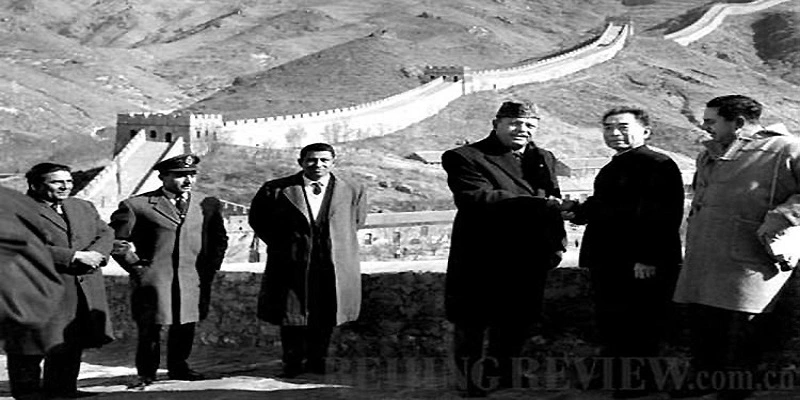President Ayub Khan's Historic 1965 Visit China
On 9 February the 9th, there was announced that President Ayub Khan would travel to China. 2 2 March 1965, President Ayub Khan and his officials departed for China for an eight-day visit. During his trip, a joint communiqué was released on the seven 7 March, in which concerns of the common interest were emphasized with the full assurance of a friendly and mutually cooperative. President Ayub Khan's travel to the Chinese in China in 1965 is significant since any Pakistani President's first visit reflected the changes in Pakistan's foreign policy in the 60s. After that, virtually all of the Presidents visited China.
Pakistan accepted the Republic of China in 1950; however, diplomatic relations began in 1951. The Sinorelations between China and Pakistan relations in the initial decade can be classified into three distinct phases. The first period began between 1951 and 1954, when relations were at low levels of trade, with occasional official visits between the two countries. The second phase was initiated following the Bandung Conference, in which the exchange of talks and good progress was made to a higher degree. Much enthusiastically displayed by the Chinese side rather than the Pakistani side. The third phase began from 1957 until early 1961 when the direction of relations was downwards. In the beginning, Pakistan was an ally of America and was seen by China as a threat to communism. The border between China and Pakistan was unclear, and Chinese claimed some areas that were part of Hunza and Gilgit as their own, which was evident in their maps.
Certain statements by Pakistani officials supported Twotwo China, which weakened the relationship between the two nations. However, the relationship between India and China was at its peak in the 1950s when both countries encouraged cooperation and brotherhood. At the time of the Non-Alignment Movement, the friendship began to turn into hostile relations in India and China. America began to accord India more importance following the change in government in 1961. The Kennedy administration saw India as a nation that could thwart the rise of Communism and Chinese power in the region. Pakistan was not granted the same status even though the country was an ally, and the expectations of the Pakistani government that the USA was trying to solve the Kashmir issue by putting pressure on India in exchange for offering it a lot of help proved to be ineffective. India enjoyed the benefits of the various blocks created after the 2nd World War through its non-aligned foreign policy. The defence pacts signed by USA and India were also seen as a threat to its safety by Pakistan. This was the right moment for Pakistan to alter its foreign policy and to keep peace in its relationship with non-distant foreign countries. In 1959, the government of Pakistan offered to negotiate a border that was not clearly defined with China. The relationship began to improve when China accepted the offer to the offer after Pakistan decided to vote for its membership included in the United Nations. 1962, the Sino- India war 1962 also significantly improved relations with Pakistan and China because China's support for Pakistan was primarily based on China. In 1963, the Boundary Commission started negotiations which proved effective and eventually led to The Border Agreement.
The visit by President Ayub Khan was a symbol of goodwill towards China. On his trip, he met with Chairperson Liu Shao- Chi and Premier Chou En-la. An official joint Communique was released on 7 March. The march stated that it was to make the relationship between the two nations more cooperative, and friendly discussions were held. From then on, the international policy for both nations was founded on friendly cooperation. Both countries believed that if Asian and African nations adhered to the ten principles included during the Bandung Conference, cooperation could be achieved despite the differences in their respective social systems. The significance of these points was exemplified through the relationships with Pakistan and China.
Both countries were happy to have completed the task of border demarcation stipulated in the border agreement in March 1963. The Chinaboundary commission of China - Pakistan boundary commission proved competent for the job that could improve the relationship between the two nations. Both countries agreed that to achieve political independence, the main prerequisite is the development of their economy of African as well as Asian countries. Both countries focused on the importance of cultural cooperation. They both agreed that racial discrimination and colonialism are the biggest obstacles any nation faces to achieving independence, so these hurdles must be overcome to ensure a peaceful world. Asian-African Solidarity may be a crucial factor in completing the process. They are against the nuclear weaponization process in South-East Asia as that would increase the danger of mass destruction. They also emphasized the ban on the use of nuclear weapons. Both countries hope the Sino-Indian boundary agreement could be realized shortly via negotiations that bring peace to the region. President Ayub has reiterated that United Nations should recognize China, and the idea that involves two China should be scrapped. They both agreed they believe that the unanswered Kashmir issue is a matter of grave concern for peace and that the United Nations must resolve it following the wishes of the Kashmiri people. Ayub was the President of the United Nations. Ayub was also able to invite China's Chinese chairman to Pakistan, which was greeted with warm acceptance. When he returned from China on 9 9 March 1965, he was delighted by the progress made during the trip.
The trip was of significant importance in Pakistan's foreign policies. Pakistan because Pakistan began its friendship with China. The friendship proved beneficial in the years to come since China was an all-weather friend. China has proved itself a true partner by assisting Pakistan through tough times.

